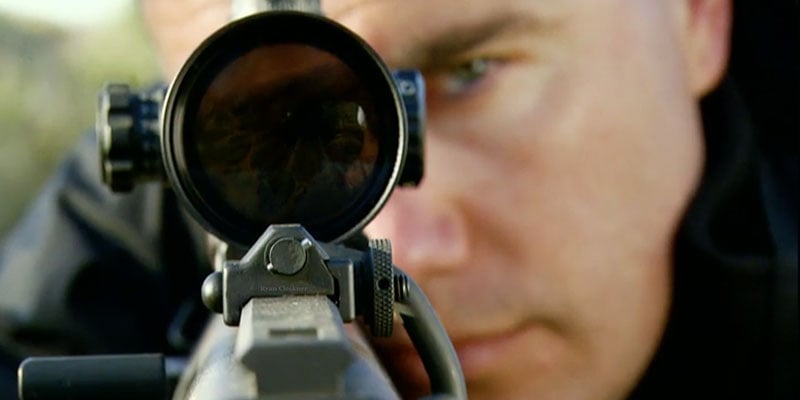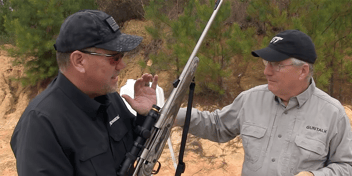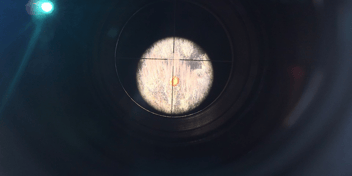
There are many variables that affect your bullet’s path after it leaves the barrel of your rifle. Knowing what each of the variables are and how they may make a difference to your bullet’s trajectory are an important part of successfully shooting at longer ranges.
The biggest effect, gravity, is also the easiest to account for. A bullet is going to drop effectively the same amount in a given amount of time anywhere on Earth.
Therefore, you can figure out how far your bullet drops, and coincidentally how much you need to compensate with your scope’s elevation adjustment, when you shoot at a 500 yard target. Then, the next time you shoot at 500 yards with that same bullet/cartridge combination out of the same rifle/scope combination, you can reference your previous adjustment and use it again. It’s that easy.
Wait, I’ve got some bad news… it’s actually a bit more complicated than that. You see, changes in the environment like the density (thickness) of the air and the temperature can change how long it takes for your bullet to hit that same 500 yard target. If the bullet takes longer to get there, it’s going to be exposed to gravity longer and it’s going to impact lower than it did the last time you shot at that target.
Wind, which has the second greatest effect on your bullet, is the hardest variable to account for because it can change right after you figure it out. Like gravity, wind will have more of an effect on a bullet the longer it can act upon a bullet. Therefore, the quicker a bullet gets to a target, the less it is blown off of its original path by the wind.
Discussing every variable and precisely how it affects your particular bullet is a bigger conversation than we can handle in this article. Also, before we can analyze the variables, we need to know what they are and have a method to track them. Mossberg has provided a solution: their Data Card. Sign up to receive your very own Mossberg Ballistic Data Cards via email.
Let’s explore how you can use Mossberg’s Ballistic Data Card to record data from your time at the range.
Date/Time/Location
These sections aren’t as important to track for bullet performance as they are for you to reference your information. Variables will change depending on each of these three pieces of information, but you’re going to be recording them below.
Rifle/Scope
You can use nicknames here. Just know that if you change either one of these, your past information might be close, but it’s unlikely to be dead-on.
Ammunition
Include manufacturer, bullet weight, bullet type, and velocity. If any of these change, you’re likely to see a change in your data.
Distance
Each Data Card will only be good for targets at a particular distance. If you change distances, then you need to start a new Data Card.
Altitude/Humidity/Barometric Pressure (B.P.)
Each of these variables change the density (thickness) of the air. All else being equal, higher elevation/altitude results in thinner air, higher humidity results in thinner air (yes, that’s backwards from what you might think), and lower Barometric Pressure (B.P.) results in thinner air. Thinner/less-dense air allows the bullet to travel faster (not slow down as much) because there is less air resistance on the bullet.
Temperature
This will affect the bullet’s path in two ways. First, higher temperatures will result in thinner/less-dense air. Second, higher temperatures will cause the powder in your cartridge to burn faster/hotter and should result in a faster bullet. Therefore, as temperatures rise, so does the impact of your bullet on the target.
Shot/Elevation/Wind/Call
In this section you can track each bullet you shoot under the conditions you recorded above. Each data card has room for 20 shots at a target (one typical box of ammunition). You should record the elevation and windage adjustments used on your scope - these are adjustments from your “zero.” In the “call” section, you can record whether you thought the shot was good (you can use an X or a check mark) or whether you thought you pulled the shot up, down, left, or right.
Target
Record the target size and then plot where each shot ended up on the target. You’re on the path to being a great shooter when your “call” from above matches where the bullet actually impact. As a tip, you can list number on the target representing bullet impacts and then group them with a circle around the group.
Notes
In this section you can record any extra information that might seem pertinent. You can record whether you were shooting at an angle, whether your bolt was difficult to open (high pressure), and if you’d like to calculate Coriolis/Eotvos effects from the spin of the Earth, you can record your latitude and shooting direction.
Light
You can record the quality of light and the direction of the sun. Here’s a tip: if the sun is to your right, don’t be surprised if your group is a bit left. The shadow in your scope caused by the sun can cause you to think the your eye isn’t centered properly in the scope. When you readjust your eye and then shoot, it’ll cause impacts in the direction of the shadow.
Wind
You can record the speed and direction of the wind. Don’t try to get a precise wind measurement to record for each shot. First, the wind will likely change between each shot. Second, even if you do get a new reading each shot, you are only measuring what is at your location and not what is happening at each distance from you to the target.
About the Author






